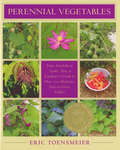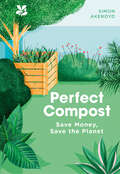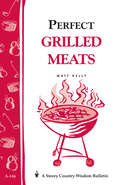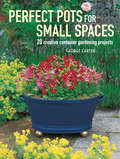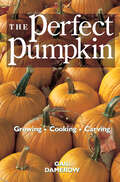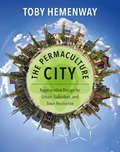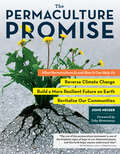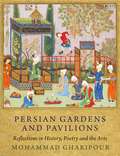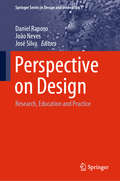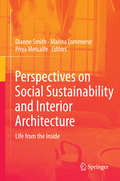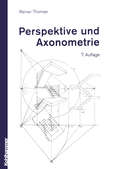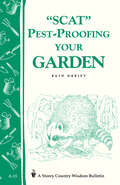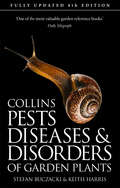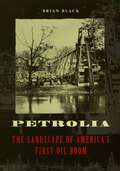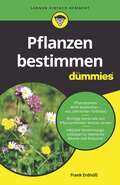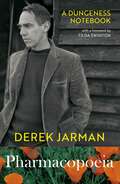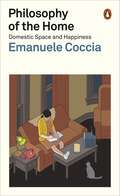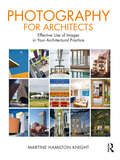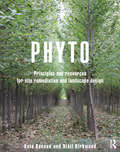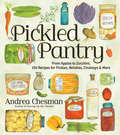- Table View
- List View
Perennial Vegetables: From Artichokes to Zuiki Taro, A Gardener's Guide to Over 100 Delicious and Easy to Grow Edibles
by Eric ToensmeierThere is a fantastic array of vegetables you can grow in your garden, and not all of them are annuals. In Perennial Vegetables the adventurous gardener will find information, tips, and sound advice on less common edibles that will make any garden a perpetual, low-maintenance source of food. Imagine growing vegetables that require just about the same amount of care as the flowers in your perennial beds and borders—no annual tilling and potting and planting. They thrive and produce abundant and nutritious crops throughout the season. It sounds too good to be true, but in Perennial Vegetables author and plant specialist Eric Toensmeier (Edible Forest Gardens) introduces gardeners to a world of little-known and wholly underappreciated plants. Ranging beyond the usual suspects (asparagus, rhubarb, and artichoke) to include such "minor" crops as ground cherry and ramps (both of which have found their way onto exclusive restaurant menus) and the much sought after, anti-oxidant-rich wolfberry (also known as goji berries), Toensmeier explains how to raise, tend, harvest, and cook with plants that yield great crops and satisfaction. Perennial vegetables are perfect as part of an edible landscape plan or permaculture garden. Profiling more than 100 species, illustrated with dozens of color photographs and illustrations, and filled with valuable growing tips, recipes, and resources, Perennial Vegetables is a groundbreaking and ground-healing book that will open the eyes of gardeners everywhere to the exciting world of edible perennials.
Perfect Compost: A Practical Guide
by Simon Akeroyd National Trust BooksLearn how to make and use nourishing compost for your garden with this handy little guidebook from an experienced National Trust head gardener.
Perfect Grilled Meats: Storey's Country Wisdom Bulletin A-146 (Storey Country Wisdom Bulletin)
by Matt KellySince 1973, Storey's Country Wisdom Bulletins have offered practical, hands-on instructions designed to help readers master dozens of country living skills quickly and easily. There are now more than 170 titles in this series, and their remarkable popularity reflects the common desire of country and city dwellers alike to cultivate personal independence in everyday life.
Perfect Money Saving (The\perfect Ser.)
by Smita Talati- Do you find you're always strapped for cash at the end of the month?- Are you worried about paying your credit card bills?- Would you like some practical advice on how to make your money go further?Perfect Money Saving is the essential guide for anyone who wants to take control of their finances. Covering everything from home-made presents to cheaper mortgages, it gives step-by-step guidance on how to cut your costs without giving up the things you enjoy. With sections on debt management and your financial portfolio, as well as a month-by-month breakdown showing where and when to grab the best bargains, Perfect Money Saving has all you need to make the most of every penny.The Perfect series is a range of practical guides that give clear and straightforward advice on everything from getting your first job to choosing your baby's name. Written by experienced authors offering tried-and-tested tips, each book contains all you need to get it right first time.
Perfect Pots for Small Spaces: 20 creative container gardening projects
by George CarterCombining inspiration with practicality, Perfect Pots for Small Spaces offers 20 exciting projects, each simple enough to complete in a weekend.Containers come in all sorts of materials, sizes and shapes, and can be used to enhance any outdoor space, from a small terrace to a large garden. In this highly informative and superbly illustrated book, award-winning gardener George Carter explains how to make the most of them. Divided into four sections – on terra cotta, masonry, metal and wood – it has step-by-step instructions and ideas for seasonal planting plans that make container gardening accessible to all. Among the imaginative projects are painted pots, a wirework hanging basket, a rustic window box, a trough with trellis screen, a wooden obelisk and a painted galvanised washtub. The projects are complemented by a plant directory, information on care and maintenance of containers and plants and an extensive list of resources.
The Perfect Pumpkin: Growing/Cooking/Carving
by Gail DamerowThe big orange pumpkin is no longer just for Halloween! Gail Damerow shows you how to cultivate more than 95 varieties of pumpkin, and provides recipes for pumpkin pies, muffins, and even pumpkin beer. You&’ll also learn how to use pumpkins in a variety of craft projects, from carving unique jack-o&’-lanterns to creating pumpkin-scented creams and soaps. With tips on growing giant pumpkins, preserving your harvest through the winter, and much more, The Perfect Pumpkin will delight pumpkin lovers of all sensibilities.
The Permaculture City: Regenerative Design for Urban, Suburban, and Town Resilience
by Toby HemenwayPermaculture is more than just the latest buzzword; it offers positive solutions for many of the environmental and social challenges confronting us. And nowhere are those remedies more needed and desired than in our cities. The Permaculture City provides a new way of thinking about urban living, with practical examples for creating abundant food, energy security, close-knit communities, local and meaningful livelihoods, and sustainable policies in our cities and towns. The same nature-based approach that works so beautifully for growing food—connecting the pieces of the landscape together in harmonious ways—applies perfectly to many of our other needs. Toby Hemenway, one of the leading practitioners and teachers of permaculture design, illuminates a new way forward through examples of edge-pushing innovations, along with a deeply holistic conceptual framework for our cities, towns, and suburbs. The Permaculture City begins in the garden but takes what we have learned there and applies it to a much broader range of human experience; we’re not just gardening plants but people, neighborhoods, and even cultures. Hemenway lays out how permaculture design can help towndwellers solve the challenges of meeting our needs for food, water, shelter, energy, community, and livelihood in sustainable, resilient ways. Readers will find new information on designing the urban home garden and strategies for gardening in community, rethinking our water and energy systems, learning the difference between a “job” and a “livelihood,” and the importance of placemaking and an empowered community. This important book documents the rise of a new sophistication, depth, and diversity in the approaches and thinking of permaculture designers and practitioners. Understanding nature can do more than improve how we grow, make, or consume things; it can also teach us how to cooperate, make decisions, and arrive at good solutions.
The Permaculture Promise: What Permaculture Is and How It Can Help Us Reverse Climate Change, Build a More Resilient Future on Earth, and Revitalize Our Communities
by Jono NeigerThe Permaculture Promise offers an optimistic, innovative approach to reversing direction and adopting practices that will regenerate, rather than exhaust, Earth&’s resources.
Persian Gardens and Pavilions: Reflections in History, Poetry and the Arts (International Library of Iranian Studies)
by Mohammad GharipourFrom Timur's tent in Samarqand to Shah 'Abbas's palace in Isfahan and Humayun's tomb in Delhi, the pavilion has been an integral part of Persianate gardens since its earliest appearance at the Achaemenid garden in Pasargadae in the sixth century BC. Here, Mohammad Gharipour places both the garden and the pavilion within their historical, literary and artistic contexts, emphasizing the importance of the pavilion, which has hitherto been overlooked in the study of Iranian historical architecture. Starting with an examination of the depictions and representations of gardens in religious texts, Gharipour analyses the how the idea of the garden developed from the model of pre-Islamic gardens in Achaemenid and Sassanian Persia to its mentions in the Zoroastrian text of Aban Yasht and on to its central role as paradise in the Qur'an. Continuing on with an exploration of gardens and pavilions in Persian poetry, Gharipour offers in-depth analysis of their literal and metaphorical values. It is in the poetry of major Persian poets such as Ferdowsi, Naser Khosrow, Sa'di, Rumi and Hafez that Gharipour finds that whilst gardens are praised for their spiritual values, they also contain significant symbolic worth in terms of temporal wealth and power. Persian Gardens and Pavilions then goes onto examine the garden and the pavilion as reflected in Persian miniature painting, sculpture and carpets, as well as accounts of travelers to Persia. With masters such as Bizhad representing daily life as well as the more mystical prose and poetry in, for example, Sa'di's Bustan (The Orchard) and Golestan (The Rose Garden), the garden and the pavilion can be seen to have crucial semiotic significances and cultural meanings. But in addition to this, they also point to historical patterns of patronage and ownership which were of central importance in the diplomatic and social life of the royal courts of Persia. Gharipour thereby highlights the metaphorical, spiritual, symbolic and religious aspects of gardens, as well as their more materialistic and economic functions. This book reaches back through Persia's rich history to explore the material and psychological relationships between human beings, pavilions and gardens, and will be a valuable resource for Art History, Architecture and Iranian Studies.
Perspective Drawing for Interior Space
by Christopher NataleUsing step-by-step instructions together with line-colored drawings, Perspective Drawing for Interior Space offers procedural instruction that covers freehand and technical one-, two-, and three-point perspectives. This text begins with the basic fundamentals of perspective by utilizing geometric shapes (cubes, cones, pyramids) and then advances beyond the core skills, to creating furniture, and finally, complete interior spaces. Students will learn to use grids to help them draw scale and proportion in perspective. The text also teaches students to use floor plans and elevations to create these drawings.
Perspective on Design: Research, Education and Practice (Springer Series in Design and Innovation #1)
by Daniel Raposo João Neves José SilvaThis book presents the outcomes of recent endeavors that are expected to foster significant advances in the areas of communication design, fashion design, interior design, and product design, as well as overlapping areas. The fourteen chapters highlight carefully selected contributions presented during the 6th EIMAD conference, held on February 22–23, 2018 at the School of Applied Arts, Campus da Talagueira, in Castelo Branco, Portugal. They report on outstanding advances that offer new theoretical perspectives and practical research directions in design, and which are aimed at fostering communication in a global, digital world, while also addressing key individual and societal needs.
Perspectives on Social Sustainability and Interior Architecture: Life from the Inside
by Dianne Smith Marina Lommerse Priya MetcalfeThis book argues that interior architects have a responsibility to practice their profession in collaborative ways that address the needs of communities and of to be the agents of social justice and cultural heritage. The book is divided into three sections, based on three pivotal themes — community engagement, social justice and cultural heritage. Each section has chapters that put forward the principles of these themes, leading into a variety of fascinating case studies that illustrate how socially sustainable design is implemented in diverse communities across the world. The second section includes four concise case studies of community housing issues, including remote-area indigenous housing and housing for the homeless. The third section offers two extensively researched essays on design and cultural heritage — a case study of the development of a redundant industrial site and a historical study of gendered domestic interiors.The book appeals to a wider audience than the design community alone and challenges mainstream interior design/interior architecture practitioners nationally and internationally to take a leading role in the field of socially responsible design. The issues raised by the authors are relevant for individuals, communities, government and non-government organisations, professionals and students.“In the twenty-first century we seem to have entered into a new world of knowledge discovery, where many of the most exciting insights come not from the authority of a traditional discipline, but from the dialogue that happens at the hubs and intersections of thought — the arenas where different disciplines and approaches, different schools and habits of thinking, come together to collaborate and contend. This collection is a good example of this, and I hope the book will be widely read and its lessons learned and applied.”Tim Costello, Officer of the Order of Australia, Chief Executive, World Vision Australia.
Perspektive und Axonometrie
by Reiner ThomaeNoch immer ist die Kenntnis und die Lehre von der Perspektive für die räumliche Darstellung geplanter Objekte unentbehrlich. Dies wird sich trotz Fotografie und Computer-Aided-Design (CAD) nicht ändern. Das Buch erklärt das Wesentliche zur Perspektive anhand leicht verständlicher Beispiele, wobei die Zeichnung im Mittelpunkt steht, ergänzt um knappe Erläuterungen. Diese Perspektivlehre ist vor allem für diejenigen gedacht, die sich mit der Planung neuer Objekte befassen - für Architekten und Designer, aber auch für den interessierten Laien. Vorkenntnisse sind nicht erforderlich.
Pest-Proofing Your Garden: Storey's Country Wisdom Bulletin A-15 (Storey Country Wisdom Bulletin)
by Ruth HarleySince 1973, Storey's Country Wisdom Bulletins have offered practical, hands-on instructions designed to help readers master dozens of country living skills quickly and easily. There are now more than 170 titles in this series, and their remarkable popularity reflects the common desire of country and city dwellers alike to cultivate personal independence in everyday life.
Pests, Diseases and Disorders of Garden Plants (Collins Photo Guide Ser.)
by Stefan Buczacki Keith HarrisEssential for all gardeners, horticulturists, teachers, students and naturalists, this is a practical guide to dealing with the pests, diseases and disorders that commonly affect fruit, vegetables, trees and ornamental garden plants.
Petrolia: The Landscape of America's First Oil Boom (Creating the North American Landscape)
by Brian BlackIn Petrolia, Brian Black offers a geographical and social history of a region that was not only the site of America's first oil boom but was also the world's largest oil producer between 1859 and 1873. Against the background of the growing demand for petroleum throughout and immediately following the Civil War, Black describes Oil Creek Valley's descent into environmental hell. Known as "Petrolia," the region charged the popular imagination with its nearly overnight transition from agriculture to industry. But so unrestrained were these early efforts at oil drilling, Black writes, that "the landscape came to be viewed only as an instrument out of which one could extract crude." In a very short time, Petrolia was a ruined place—environmentally, economically, and to some extent even culturally. Black gives historical detail and analysis to account for this transformation.
Pflanzen bestimmen für Dummies (Für Dummies)
by Frank ErdnüßHaben Sie sich auch schon einmal beim Spazierengehen gefragt, wie eigentlich diese wunderschöne Blume am Wegesrand heißt? Oder was für ein Zapfen Ihnen im Wald auf den Kopf gefallen ist? Ganz egal, ob Sie aktiv losziehen, um Pflanzen zu bestimmen, oder einfach nur gerne wissen, was um Sie herum wächst, dieses Buch ist eine echte Hilfe. Frank Erdnüß bietet Ihnen eine verständliche Anleitung, mit der Sie ganz leicht und eindeutig Pflanzen bestimmen können. So finden Sie die richtige Herangehensweise und lernen die verschiedenen Pflanzenfamilien samt ihren spezifischen Merkmalen kennen. Übersichtliche Bestimmungsschlüssel für die wichtigsten deutschen Pflanzenarten sowie zahlreiche Abbildungen führen Sie schnell auf die richtige Spur. Nutzen Sie dieses Buch als Nachschlagewerk und lernen Sie die Pflanzenwelt ganz neu kennen.
Pharmacopoeia: A Dungeness Notebook
by Derek Jarman'I planted a dog rose. Then I found a curious piece of driftwood and used this, and one of the necklaces of holey stones on the wall, to stake the rose. The garden had begun. I saw it as a therapy and a pharmacopoeia.' In 1986 artist and filmmaker, Derek Jarman, bought Prospect Cottage, a Victorian fisherman's hut on the desert sands of Dungeness. It was to be a home and refuge for Jarman throughout his HIV diagnosis, and it would provide the stage for one of his most enduring, if transitory projects - his garden. Conceived of as a 'pharmacopoeia' - an ever-evolving circle of stones, plants and flotsam sculptures all built and grown in spite of the bracing winds and arid shingle - it remains today a site of fascination and wonder.Pharmacopoeia brings together the best of Derek Jarman's writing on nature, gardening and Prospect Cottage. Told through journal entries, poems and fragments of prose, it paints a portrait of Jarman's personal and artistic reliance on the space Dungeness offered him, and shows the cycle of the years spent there in one moving collage.'[Derek] made of this wee house, his wooden tent pitched in the wilderness, an artwork - and out of its shingle skirts, an ingenious garden - now internationally recognised. But, first and foremost, the cottage was always a living thing, a practical toolbox for his work' Tilda Swinton, from her Foreword
Philosophy of the Home: Domestic Space and Happiness
by Emanuele CocciaA bedroom, a kitchen, a bathroom - are these rooms all that make a home? Not at all, argues Emanuele Coccia. The buildings we inhabit are of immense psychological and cultural significance. They play a decisive role in human flourishing and, for hundreds of years, their walls and walkways, windows and doorways have guided our relationships with others and with ourselves. They reflect and reinforce social inequalities; they allow us to celebrate and cherish those we love. They are the places of return that allow us to venture out into the world.In this intimate, elegantly argued account, Coccia shows how the architecture of home has shaped, and continues to shape, our psyches and our societies, before then masterfully leading us towards a more creative, ecological way of dwelling in the world.
Photography for Architects: Effective Use of Images in Your Architectural Practice
by Martine Hamilton Knight***Shortlisted for the Architectural Book Awards 2024***We live in a world driven by images, but with so much visual noise, is anyone really looking? How does an architect ensure their portfolio is within view of the right audience? Photographs are still as vital to architectural practice as they ever were. However, creation and circulation, once in the hands of skilled professionals, is now perceived as being ‘free’ and within easy reach of all. But where is the clarity? What is the message? By setting out the case for curated image making, considered photography may again be placed at the centre of architectural marketing strategies.Photography for Architects guides the reader through various topics: from establishing a visual brand and sharing images online, to producing content in-house and commissioning professionals. It explores the still and moving image, creating books and exhibitions for legacy value, compiling award entries, and engaging with trade press. Little understood aspects regarding legal rights and obligations, ethics, copyright, and licensing images for use are discussed in clear language. Multiple photographic examples and conversations with international practitioners highlight the various themes throughout.Written by a working architectural photographer whose life has been spent in commercial practice, this easy-to-read, richly illustrated guide is essential reading for architects and designers alike who are working with images and image makers.
Physical Security Assessment Handbook: An Insider’s Guide to Securing a Business
by Michael KhairallahPhysical Security Assessment Handbook: An Insider’s Guide to Securing a Business, Second Edition has been fully updated to help you identify threats to your organization and be able to mitigate such threats. The techniques in this comprehensive book outline a step-by-step approach to: Identify threats to your assets Assess physical security vulnerabilities Design systems and processes that mitigate the threats Set a budget for your project and present it to company managers Acquire the products through competitive bidding Implement the recommended solutions Each chapter walks you through a step in the assessment process, providing valuable insight and guidance. There are illustrations and checklists that help simplify the process and ensure that the right course is taken to secure your company. This book provides seasoned advice on the competitive bidding process as well as legal issues involved in facility security. After reading it, you will know how to assess your security needs, specify the right products, and oversee and manage the project and installation. It concludes with project implementation, and the necessary follow-up after installation, to verify the proper use of the new security solutions. Physical Security Assessment Handbook, Second Edition provides a structure for best practices in both specifying system components as well as managing the acquisition and implementation process. It represents the culmination of the author’s 44 years of experience in the design, installation, and project management of security system solutions. This is a valuable resource for security managers, security consultants, and even experienced industry professionals to best approach and organize security assessment projects.
Physical Security Assessment Handbook: An Insider’s Guide to Securing a Business
by Michael KhairallahPhysical Security Assessment Handbook: An Insider’s Guide to Securing a Business, Second Edition has been fully updated to help you identify threats to your organization and be able to mitigate such threats. The techniques in this comprehensive book outline a step-by-step approach to: Identify threats to your assets Assess physical security vulnerabilities Design systems and processes that mitigate the threats Set a budget for your project and present it to company managers Acquire the products through competitive bidding Implement the recommended solutions Each chapter walks you through a step in the assessment process, providing valuable insight and guidance. There are illustrations and checklists that help simplify the process and ensure that the right course is taken to secure your company. This book provides seasoned advice on the competitive bidding process as well as legal issues involved in facility security. After reading it, you will know how to assess your security needs, specify the right products, and oversee and manage the project and installation. It concludes with project implementation, and the necessary follow-up after installation, to verify the proper use of the new security solutions. Physical Security Assessment Handbook, Second Edition provides a structure for best practices in both specifying system components as well as managing the acquisition and implementation process. It represents the culmination of the author’s 44 years of experience in the design, installation, and project management of security system solutions. This is a valuable resource for security managers, security consultants, and even experienced industry professionals to best approach and organize security assessment projects.
Phyto: Principles and Resources for Site Remediation and Landscape Design
by Kate Kennen Niall KirkwoodWinner of the 2017 CBHL Literature Award of Excellence in Landscape Design and Architecture Phyto presents the concepts of phytoremediation and phytotechnology in one comprehensive guide, illustrating when plants can be considered for the uptake, removal or mitigation of on-site pollutants. Current scientific case studies are covered, highlighting the advantages and limitations of plant-based cleanup. Typical contaminant groups found in the built environment are explained, and plant lists for mitigation of specific contaminants are included where applicable. This is the first book to address the benefits of phytotechnologies from a design point of view, taking complex scientific terms and translating the research into an easy-to-understand reference book for those involved in creating planting solutions. Typically, phytotechnology planting techniques are currently employed post-site contamination to help clean up already contaminated soil by taking advantage of the positive effects that plants can have upon harmful toxins and chemicals. This book presents a new concept to create projective planting designs with preventative phytotechnology abilities, ‘phytobuffering’ where future pollution may be expected for particular site programs. Filled with tables, photographs and detailed drawings, Kennen and Kirkwood's text guides the reader through the process of selecting plants for their aesthetic and environmental qualities, combined with their contaminant-removal benefits.
Phyto: Principles and Resources for Site Remediation and Landscape Design
by Kate Kennen Niall KirkwoodWinner of the 2017 CBHL Literature Award of Excellence in Landscape Design and Architecture Phyto presents the concepts of phytoremediation and phytotechnology in one comprehensive guide, illustrating when plants can be considered for the uptake, removal or mitigation of on-site pollutants. Current scientific case studies are covered, highlighting the advantages and limitations of plant-based cleanup. Typical contaminant groups found in the built environment are explained, and plant lists for mitigation of specific contaminants are included where applicable. This is the first book to address the benefits of phytotechnologies from a design point of view, taking complex scientific terms and translating the research into an easy-to-understand reference book for those involved in creating planting solutions. Typically, phytotechnology planting techniques are currently employed post-site contamination to help clean up already contaminated soil by taking advantage of the positive effects that plants can have upon harmful toxins and chemicals. This book presents a new concept to create projective planting designs with preventative phytotechnology abilities, ‘phytobuffering’ where future pollution may be expected for particular site programs. Filled with tables, photographs and detailed drawings, Kennen and Kirkwood's text guides the reader through the process of selecting plants for their aesthetic and environmental qualities, combined with their contaminant-removal benefits.
The Pickled Pantry: From Apples to Zucchini, 150 Recipes for Pickles, Relishes, Chutneys & More
by Andrea ChesmanBlending your grandmother&’s pickling know-how with today&’s Internet resources, Andrea Chesman shows you how easy it is to fill your pantry with tasty homemade sauerkraut, Salt-Cured Dilly Beans, and Rosemary Onion Confit. Explaining classic techniques in simple language, guiding you to helpful websites, and making you laugh with humorous stories, Chesman provides inspiration and encouragement for both first-time picklers and dedicated home canners. With tips on pickling everything from apples to zucchini, you&’ll enjoy exploring the stunning variety of flavors that can fill a Mason jar.
